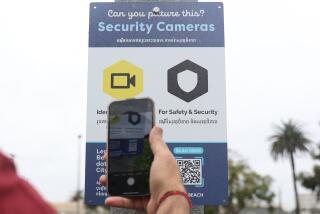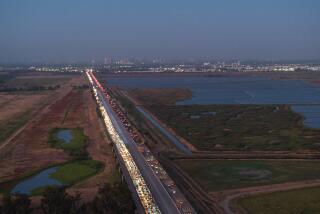Exposing Ticket Camera Flaws
The automated cameras that snap photos of motorists who run red lights help reduce intersection accidents but oversight of such programs is often lax, making cities that use the cameras vulnerable to lawsuits, according to a state audit released Tuesday.
The audit also found that the red-light cameras--used by 20 cities in California, including Los Angeles, Beverly Hills and Long Beach--rarely generate hefty ticket revenues. In fact, only San Diego and Oxnard reported making significant returns above the cost of running the camera systems.
For the record:
12:00 a.m. July 25, 2002 For The Record
Los Angeles Times Thursday July 25, 2002 Home Edition Main News Part A Page 2 National Desk 15 inches; 537 words Type of Material: Correction
Red-light cameras--An article in Wednesday’s California section incorrectly reported the effect that automated red-light cameras have had on traffic accidents in San Diego. Since the red-light cameras were discontinued last year, accidents have increased 14% citywide and 30% at those intersections where the cameras were installed.
The audit by California State Auditor Elaine Howle also found that some cities--none of which were named--have used the photos to investigate other crimes besides red-light violations.
Howle said the auditing team’s attorneys believe state law prohibits such use of the photographs.
“In view of these conflicting interpretations of the law, the courts will ultimately decide whether local governments are violating the red-light camera law when using the photographs in criminal investigations,” the audit concluded.
A spokesman for the Libertarian Party of California criticized the use of red-light cameras, saying law enforcement agencies that use the photographs to investigate other crimes are abusing the program and violating the privacy of motorists.
“It’s totally foreseeable that this would happen,” said David Molony, executive director of the Libertarian Party of California. “The price [we are paying] is we are losing privacy rights.”
But the program has some avid supporters too.
“My 8-year-old son, Brent, was killed by a woman speeding through a red light because she was late to work,” said Toni Adams, a Brea mother who counts herself as a fan of the red-light enforcement program.
“Our family will never be whole again. Those seconds saved by running a red light can cost someone their life.”
Since being introduced to this country from Europe a decade ago, the red-light cameras have proliferated throughout the nation, from Alexandria, Va., to Beaverton, Ore.
The cameras, installed on poles near dangerous intersections, are linked to sensors in the pavement and synchronized with the traffic lights to snap photos of cars that cross a line after the light turns red.
Private firms hired to operate the cameras use the photos to discern the license plates and identify the drivers. If the photo is clear and the violation is obvious, local police are contacted and a citation is mailed to the car owner.
The audit, which studied seven of the 20 California cities that use the cameras, found that only 23% of the potential violators are cited. The most common problems: blurry photographs and vehicles without front license plates.
In California, red-light violations resulted in 93 deaths and nearly 15,000 injuries in 2000, according to the California Highway Patrol.
The audit found that accidents declined by an average of 10% in cities that deployed red-light cameras.
But the technology has not come without controversy. Last year, a judge threw out nearly 300 citations in San Diego after ruling that the city failed to closely supervise the private company hired to install and run the cameras. The city has since suspended the camera program.
The audit warned that other cities must also closely monitor the private firms that operate the cameras or risk similar rulings and civil judgments.
It also recommended that cities regularly inspect the cameras and monitor the companies handling the photographs.
A spokeswoman for Affiliated Computer Services, the nation’s largest provider of red-light cameras, promised to work with local cities to implement the audit recommendations.
“We welcome any recommendations that minimize legal challenges and further citizen and driver confidence and support,” said spokeswoman Janis Langley.
San Diego Police Chief David Bejarano said he agrees with the audit’s findings and plans to implement all the recommendations before reactivating the city’s red-light cameras in September.
Despite the setbacks, Bejarano said the red-light cameras served a valuable purpose in San Diego, reducing accidents 14% citywide and 30% at those intersections where the cameras were installed.
Bejarano and other law enforcement officials said they have not used the photographs from the red-light cameras to investigate other crimes.
But a Long Beach police spokesman said lawyers for the city believe police can use the photographs to investigate crimes committed by the motorists who run red lights.
For example, if a driver strikes a pedestrian while running a red light, the photograph of the car can be used to prosecute the motorist for the accident, said Long Beach Det. David Lauro.
In the city of Los Angeles, the red-light camera program sparked a debate in City Hall after the vendor, Affiliated Computer Services, delayed installation of eight cameras because of a dispute over the citation fees. The dispute has since been settled.
Still, Los Angeles officials said the program has yet to generate significant revenues.
“Our intention was always to prevent traffic accidents,” said Adena Tessler, an aide to Councilwoman Cindy Miscikowski. “It was never our intention to make money.”
More to Read
Sign up for Essential California
The most important California stories and recommendations in your inbox every morning.
You may occasionally receive promotional content from the Los Angeles Times.











